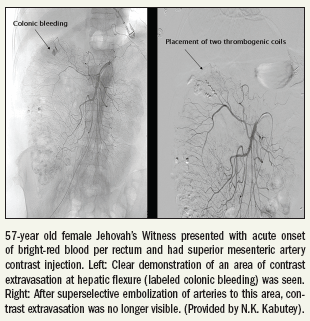Interventional radiology finds new patients in Jehovah’s Witnesses
Radiologists from Boston Medical Center are using interventional techniques to treat bleeding Jehovah's Witness patients.
Radiologists from Boston Medical Center are using interventional techniques to treat bleeding Jehovah's Witness patients.
The Jehovah's Witness movement was established by Charles Russell in Pennsylvania in the 1870s and now has six million followers worldwide. Issues with blood transfusions were first described in the July 1945 edition of The Watchtower, the movement's official publication.
Followers believe ingestion of blood can result in loss of eternal life, eternal damnation, and excommunication from their congregation. Many also believe that individuals offering to transfuse blood are acting through the devil's influence.
Acceptable medical treatments for church members include most surgical/ interventional procedures and anesthesiologic blood conservation methods, as well as diagnostic and therapeutic procedures, synthetic oxygen therapeutics, nonblood volume expanders, pharmacologic agents that do not contain blood components or fractions such as vasoconstrictors, agents that enhance hematopoiesis, and recombinant products, said Dr. Nii-Kabu Kabutey, lead author of the Boston group's RSNA 2009 education exhibit.

Other procedures acceptable to the elders of Jehovah's Witness include apheresis, hemodialysis, plasma-derived fractions (immunoglobulins, vaccines, antivenins, albumin, cryoprecipitate), hemostatic products containing blood fractions (fibrin glue and/or sealant), and hemostatic bandages containing plasma fractions and thrombin sealants.
Many church members have problems finding a physician who will treat them in accordance with their beliefs, and they fear their beliefs will not be respected during a medical emergency. Conversely, some physicians think these beliefs are at odds with their duty to promote a patient's well-being, according to Kabutey.
Before a procedure, the Boston Medical Center team evaluates the patient's history of bleeding or previous hematologic or thrombotic disorders, plus the individual's family history in this area.
Team members then obtain a modified informed consent, aggressively treat anemia, work to minimize iatrogenic blood loss and the number of blood samples taken, and use pediatric tubes. They use various techniques to limit blood loss and reduce transfusion requirements, including meticulous hemostasis and use of closure devices to the puncture site, good manual compression at the puncture site, and reverse anticoagulation if clinically feasible.
After the procedure, further methods are used to reduce blood loss, such as close clinical follow-up, minimizing oxygen consumption, and maximizing oxygen saturation.
“Understanding the social and clinical challenges in the treatment of Jehovah's Witness patients is essential to provide quality care,” Kabutey said. “Proper preprocedural planning can improve the outcome of interventional procedures on bleeding patients.”
One of the group's success stories was a 57-year-old female Jehovah's Witness with an acute onset of brightred blood per rectum. A colonoscopy did not reveal any abnormal pathology. Embolization of the right colonic artery was successful, and the patient did not require a transfusion or surgical intervention.
In another case, a 33-year-old female JW presented acutely with postpartum hemorrhage. She refused a transfusion and wanted to avoid a hysterectomy. Bilateral embolization of uterine arteries was accomplished with Gelfoam. Her bleeding stopped after the procedure, and she did not require a hysterectomy.
What New Research Reveals About Novice Use of AI-Guided Cardiac Ultrasound
April 4th 2025In a study recently presented at the American College of Cardiology (ACC) conference, researchers found that novice use of AI-guided cardiac ultrasound after an AI-enabled electrocardiogram increased the positive predictive value for reduced left ventricular ejection fraction (LVEF) or aortic valve stenosis by 33 percent.
The Reading Room Podcast: Current Perspectives on the Updated Appropriate Use Criteria for Brain PET
March 18th 2025In a new podcast, Satoshi Minoshima, M.D., Ph.D., and James Williams, Ph.D., share their insights on the recently updated appropriate use criteria for amyloid PET and tau PET in patients with mild cognitive impairment.
Study with CT Data Suggests Women with PE Have More Than Triple the One-Year Mortality Rate than Men
April 3rd 2025After a multivariable assessment including age and comorbidities, women with pulmonary embolism (PE) had a 48 percent higher risk of one-year mortality than men with PE, according to a new study involving over 33,000 patients.
GE HealthCare Debuts AI-Powered Cardiac CT Device at ACC Conference
April 1st 2025Featuring enhanced low-dose image quality with motion-free images, the Revolution Vibe CT system reportedly facilitates improved diagnostic clarity for patients with conditions ranging from in-stent restenosis to atrial fibrillation.





















